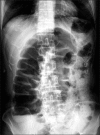Report of an unusual case with severe fecal impaction responding to medication therapy
- PMID: 20535352
- PMCID: PMC2879854
- DOI: 10.5056/jnm.2010.16.2.199
Report of an unusual case with severe fecal impaction responding to medication therapy
Abstract
Fecal impaction is a disorder characterized by a large mass of compacted feces in the rectum and/or colon, which cannot be evacuated. For mild and moderate fecal impaction, recommended treatments include stool softeners, oral mineral and olive oil, and edema; for severe fecal impaction, manual removal is needed and sometimes laparotomy may be indicated if medical therapies are not effective. Here we report a case with severe fecal impaction who did not defecate for 75 days. We treated this patient with vegetable oil, Chinese traditional medicine and enema in sequence. After 12 days of therapy, she evacuated hard fecal masses, and the symptoms were relieved.
Keywords: Fecal impaction; Intestinal obstruction; Therapy.
Conflict of interest statement
Conflicts of interest: None.
Figures



References
-
- Read NW, Celik AF, Katsinelos P. Constipation and incontinence in the elderly. J Clin Gastroenterol. 1995;20:61–70. - PubMed
-
- Mahajna A, Krausz MM. Ileocolic intussusception in an adult patient due to a cecal fecalith. Isr Med Assoc J. 2009;11:58–59. - PubMed
-
- Arana-Arri E, Cortés H, Cabriada V, Lekerika N, García-Verdugo A, Shengelia-Shapiro L. Giant faecaloma causing perforation of the rectum presented as a subcutaneous emphysema, pneumoperitoneum and pneumomediastinum: a case report. Eur J Emerg Med. 2007;14:351–353. - PubMed
-
- Creason N, Sparks D. Fecal impaction: a review. Nurs Diagn. 2000;1:15–23. - PubMed
LinkOut - more resources
Full Text Sources

